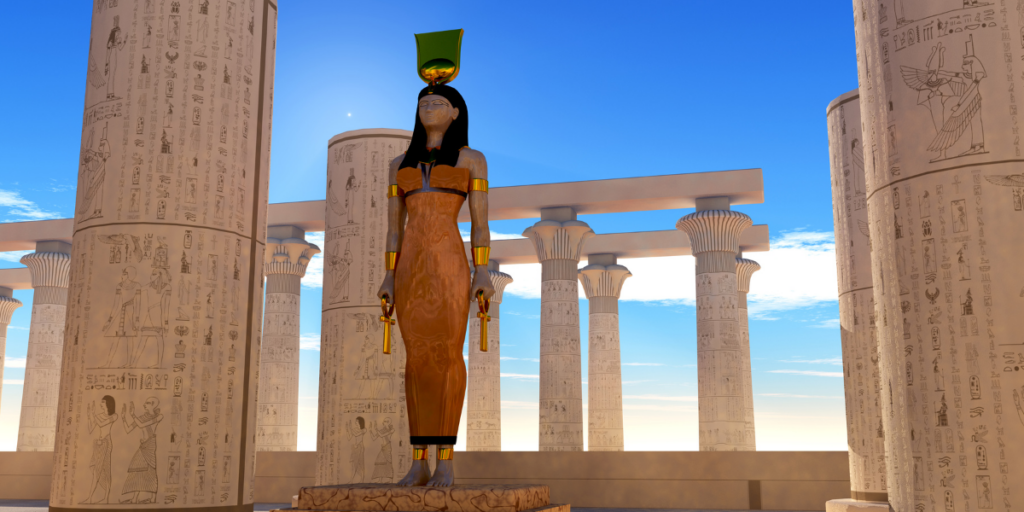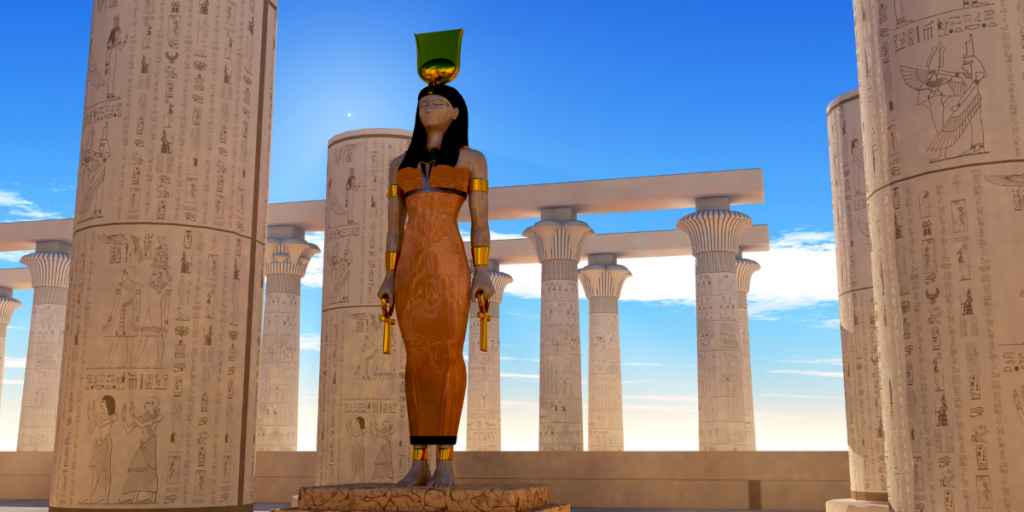Beauty (or attractiveness), procreation; magic; and even death- These attributes are associated with goddesses of love. Gods and goddesses are accountable for many of the mysteries of existence. The process of conception is one of life’s greatest enigmas, and a family or race’s ability to reproduce and attract mates is critical to its existence.

Humans form close bonds with one another because of the complicated feelings they refer to as love. The deities who bestowed these gifts in ancient communities and a change in their names are all that separates some of these love queens from one other.
Goddess of Love
We know that different people worship different Gods and Goddesses. Moreover, every mythology has a different story to narrate. Here, we have other goddesses termed ‘Goddess of love’ in various mythologies. Let us know the popular folklore behind them.
Greek Mythology- Aphrodite

The name Aphrodite can be split into two parts: Aphros, which means ‘foam,’ and Hesiod represents ‘Theogony.’ It suggests that this Goddess of love was born from the white foam. The genitals of Uranus produced this foam. After his son Cronus threw this foam into the sea, Aphrodite was born.
Beautiful and passionate Aphrodite embodied love and beauty in ancient Greece’s pantheon. To show his love for Aphrodite, Paris gave her the fruit that caused strife; in Greek Mythology: the apple of discord.
She supported the Trojans throughout the battle. It wasn’t only humans she had ties with; she also had interactions with angels. Eros, Anteros, Hymenaios, and Aeneas are among her children. This group of women, collectively referred to as “The Graces” was part of Aphrodite’s court. They were known as “Splendor,” “Mirth,” and “Good Cheer.”
Besides, people also worship Aphrodite as a goddess of war. Some places, such as Sparta, Cyprus, Thebes, etc., name it like a goddess of war. Along with the epitome of love and fertility, Aphrodite is often honored during marriages. She is identified with Venus in Roman mythology. People also worship Aphrodite as a goddess of sea and seafaring. Some beliefs also state that Aphrodite was considered a patron for the prostitutes.
Moreover, her association with Eros, the Horae (Season), and the Graces (Charites), she was regarded as a promoter of fertility. Interestingly, Aphrodite is often symbolized as a dove, pomegranate, myrtle, and swan.
Mesopotamian Mythology- Ishtar

In Mesopotamian mythology, Ishtar is worshipped as a goddess of war and sexual love. Her association with An, the sky god, also made her the Goddess of rain and thunderstorms.
According to some mythologies, Ishtar is also considered the daughter of Nanna, the god of the moon or the wind god. Besides being An’s daughter, some mythologies also depict Ishtar as his wife.
She was often pictured with a lion to depict her association with thunder and the roar of the lion. Ishtar was worshipped as a heavenly deity because of her linkage with the planet Venus. Besides, she makes a secondary astral triad with Shamash, the sun god, and Sin, the moon god.
When it came to her boyfriends, she was notorious for killing them all. It was a heartbreak for her when she couldn’t find Tammuz, her agricultural god lover who had perished in the Underworld. As the daughter of the Sumerian deity Inanna, Ishtar had a more lustful lifestyle than her older sister.
Apart from romantic and passionate love, she is also known for familial love. Many poetries are written on this deity that describes her beauty.
Roman Mythology- Venus, Cupid

Venus came to be associated with Jupiter in a festival known as Vinalia Rustica. Hence, with the Greek deities Zeus and Aphrodite, Venus and Jupiter became known as father and daughter.
Venus was an epitome of love and beauty due to her romantic affairs and intrigues with gods and mortals. She was also a remarkable depiction of femininity. Her associations with Gods and Goddesses are honorable as she was also the daughter of Dione, the wife of Vulcan, and the mother of Cupid.
Venus, the Roman Goddess of love and beauty, reigned from a pedestal high in the city of Rome. A Roman goddess of flowers and gardens, Venus is often compared to the Greek Goddess of love and beauty, Aphrodite. Cupid’s mother was Jupiter’s daughter.
Despite her reputation for virginity, Venus had some relationships, including a marriage to Vulcan and an escapade with Mars. She was known as the harbinger of spring for both humans and the gods. Venus sends her daughter-in-law, Psyche, to the Underworld in “The Golden Ass” by Apuleius to bring back a beauty ointment.
Valentine’s Day is about the adorable baby with wings, a bow, and a quiver full of arrows. Cupid, the Roman deity of love, is shown here. According to folklore, he is the son of Venus, the Goddess of love. He is infamous for shooting his arrows at individuals to make them fall in love with him. Other rumors state he possessed a second bow that could cause people to break up with him.
Egyptian Mythology- Hathor

Hathor is an Egyptian deity who alternates between wearing a sun disk topped with horns and appearing as a cow. She has the power to wipe off the whole human race, yet she is also a goddess of love and childbirth. When Horus was concealed from Seth by Hathor, she breastfed him.
It is common to see Hathor represented as a cow, or as a lady with cow’s horns, as a powerful deity. She is a goddess of love, joy, celebration, and the well-being of women’s minds and bodies. People typically portray her as the embodiment of compassion and love. Both men and women revered her role as a goddess of childbirth and the protection she provided to both.
Hathor is associated with motherhood. Different mythologies identify Hathor with other gods and goddesses.
Hathor is identified with Aphrodite, the Greek Goddess of love. She was also worshipped with Horus, as her cult at Dandarah in Upper Egypt depicts. Some mythologies also associate Hathor with the Sun god Re of Heliopolis. They state that she was to be the daughter or the eye of Re.
Norse Mythology- Freya

A beautiful Vanir Norse goddess named Freya was known for her abilities in the realms of love, magic, and divination. Njord’s daughter, Freya, was the sister of her brother, Freyr.
Even Freya had her admirers among the men, giants, and dwarves that lived in her realm. She was able to get the Brisings necklace by having it with four dwarfs. Hildisvini, a gold-bristled boar or a chariot drawn by two cats, is Freya’s mode of transportation.
The entrancingly beautiful lady pulled by two cats in a chariot is a significant character in Norse mythology. Freya, sometimes known as Freyja, Freyia, or Free, is the name they go by. It is widely believed that Freya is a deity of love, beauty, and youth. A kind of magic she uses is called Seiyr.
The Norse Goddess of fertility, sex, beauty, love, and magic is one of the most well-known Germanic deities. “The Lady” is her moniker, and she, in several stories, as having a promiscuous character. Freyja has a long history and some notable characteristics.
Hindu Mythology- Parvati
Parvati is considered a compassionate goddess. The legends and mythologies depict her as a mature and beautiful woman. They also state that Parvati had to undergo severe aseptic discipline to win the heart of Shiva.
Ganesha, her elephant-headed son, is known to be created by Parvati on her own against the will of Lord Shiva. The sculptures and mythological objects depict the love between Parvati and Shiva adorably.
Parvati is also depicted as a spectator of Lord Shiva’s dance in many sculptures. The Tantras are among the most famous sculptures where the discussion between Lord Shiva and Parvati is written by the sects worshipping Shiva.
Before the Common Era, the worship of Parvati (and her other popular incarnations, Durga and Kali) was prevalent throughout the Indian subcontinent. Vedas, ancient Hindu traditions, do not refer to Parvati by her proper name; however, her other words do exist in these books. Some see her as a “mountain goddess,” while others see a composite of different goddesses that appeared before.
She is the wife of Shiva, the mother of their offspring, and the compassionate side of the global Goddess, Devi, in the contemporary religion.
Norse- Germanic Mythology- Frigg
Frigg, sometimes known as Friia, is Odin’s wife and the mother of Balder in Norse mythology. Marriage and motherhood were essential to her. She sought to save her son’s life in Icelandic folklore, but her efforts were vain. Several tales about her portray her as a crying mother, while others emphasize her lack of morality.
She was known as Frija (in German) and Free by other Germanic peoples; her name in English is Friday.
Conclusion
They anthropomorphized these elements of nature, giving them names and depicting them as men and women who might pray for help with harvests, births, or battle victories. Fertility was a central tenet of all ancient faiths, and we’ll look at one of the most widespread of these ideas today. Goddesses because of their connection to fertility and femininity in nature.
To find these devoted moms and seductive seductresses, we’re now exploring tales from throughout the globe, from the European Germanic cults to the far-flung and dangerous deities of South America to the serene and natural goddesses of Slavic myth.
